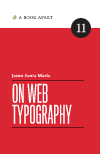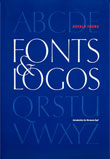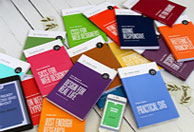Interludes in Design
I’ve noticed something interesting happening in editorial design online. More articles, and websites in general, are focusing on slowing down to not only convey their story, but to set and maintain a mood for the reader. There are many ways to do this through the writing itself, but I wanted to take a moment to point out a way that design does this through small interludes.
To see what I mean, check out this story from Matter: This is what it’s like to be at war with your body.
It’s a well considered article design-wise, lots of nice typography and whitespace for starters, but look at the bits between the text. Sometimes it’s a large and exaggerated drop cap, a big photograph, or a splash or color, but look even closer. These elements share a visual language of size, color, and placement. Now look at the drop caps. They are trimmed asymmetrically, a visual reference to the subject of this story: voluntary amputation and body integrity identity disorder.
It’s a small detail, but it does a big thing. That little treatment, the photos, colors, big type, and pull quotes are all used to maintain a mood. They pop up at intervals to check in on the reader, and to keep the story moving. They function almost like the chorus of a song, maintaining a thread to a story, sometimes alluding to where you’ve been, where you’re going, or to punctuate a point in the journey.
It’s a technique that’s been popping up in a lot of places, but doesn’t often get scrutinized. I imagine it usually gets lumped into the idea of “longform” writing or art direction, but we don’t often talk about how much heavy lifting this little technique is doing.
Similar interludes are used to great effect in other mediums like film, music, and radio. Every week when I listen to This American Life or Radiolab, I know that the pauses between segments where the music volume rises are there for a reason: they support the story by keeping me in a particular mental space. These occurrences aren’t happenstance, they’re meticulously planned, and are in direct service of the listener. They give us a moment to reflect on the story so far and prepare for what’s next. They replenish a mood over and over again, so that we can continue along with that experience and feeling a certain thing.
Seeing this kind of consideration for storytelling on the web is a serious about face. Not because writers and designers haven’t cared about storytelling, but because we may be past the point where they could still be successful despite not caring. Offhandedly dumping text into a column on a webpage used to pass for an article, but the existence of a website isn’t novel by itself anymore.
Maybe folks on the web have grown more sophisticated. Maybe there is just too much out there to sift through and small considerations like this help us find the meat. I’m happy as a designer, and as a reader, to see more people taking the time to build things striving for greater significance.
Frank Chimero’s transcripts of some of his recent presentations, What Screens Want and Designing in the Borderlands, are an exceptional example, translated from one medium to another. The New York Times garnered lots of attention with Snowfall a couple years back, but they’ve continued investing in excellent longform and interactive storytelling. Organizations like ESPN and Vox Media have been up to the same even longer and continue to push out interesting reporting. And still more folks like Victory Journal and NPR are exploring the possibilities of reporting beyond only the written word.
Consideration for communication takes effort. It’s more than just the addition of some music or moving pictures, it’s a recognition of a broader story being told. Something bigger than text casually abandoned in the corral of a webpage. It’s the acknowledgement that a story can happen in multiple dimensions, across time, sound, and image. Our stories have an ebb and flow, and design serves to support and enrich them.
This piece originally appeared on The Pastry Box Project.





 Fonts & Logos
Fonts & Logos
